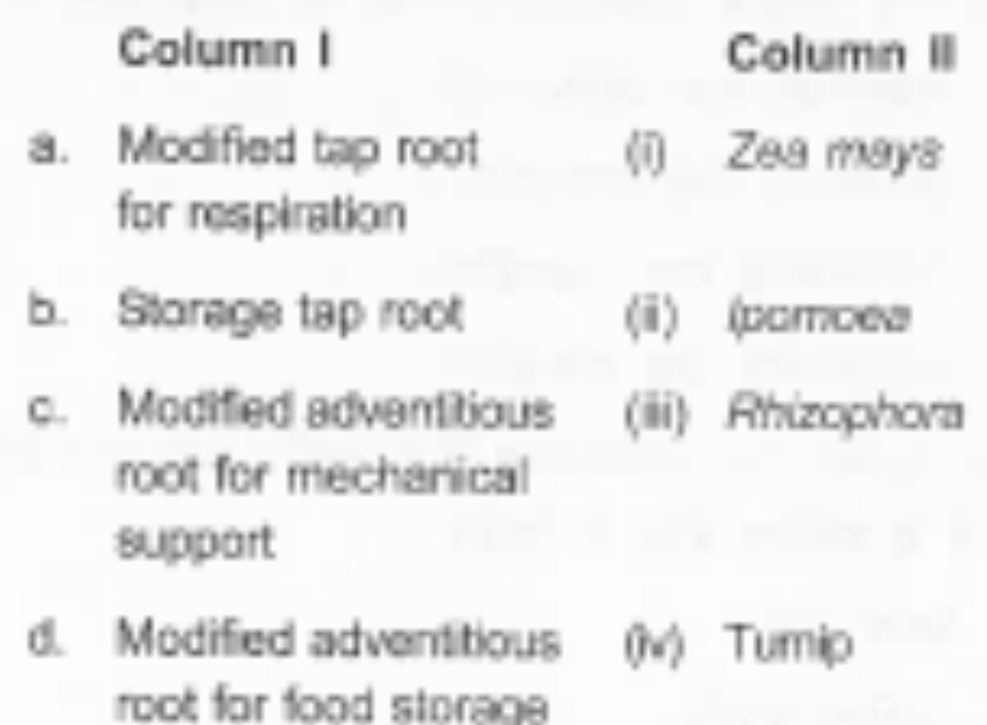Select correct match w.r.t. Whittaker' system of classification
Monera : Unicellular, osmotrophs, producers and decomposers, true, cellulosic cell wall
Protista : Unicelullar, eukaryotic, photoautotrophs and chemoautotrophs
Fungi : Multicellular tissue, eukaryotic, osmostrophs, chitinous wall
Animalia : Multicellular, eukaryotic, organ or organ system, holozoic, no saprobic
The correct Answer is:C
To solve the question regarding the correct match with respect to Whittaker's system of classification, we will analyze the characteristics of each kingdom as described in the video transcript.
1. Understanding Whittaker's Five Kingdom Classification:
- Whittaker proposed a classification system that includes five kingdoms: Monera, Protista, Fungi, Animalia, and Plantae.
2. Analyzing the Kingdom Monera:
- Monera consists of unicellular organisms that can be osmotrophs (organisms that obtain nutrients through osmosis).
- They do not have a true cellulose cell wall; instead, their cell wall is made of amino acids and polysaccharides.
- Conclusion: The statement regarding Monera having a true cellulosic cell wall is incorrect.
3. Analyzing the Kingdom Protista:
- Protista includes unicellular eukaryotic organisms, many of which are photoautotrophs (organisms that produce their own food using light energy).
- Chemoautotrophs are not a characteristic of Protista; they are found in Monera.
- Conclusion: The description of Protista as photoautotrophs is correct, but the mention of chemoautotrophs is incorrect.
4. Analyzing the Kingdom Fungi:
- Fungi are multicellular, eukaryotic organisms that are osmotrophs and have a chitinous cell wall.
- This description aligns with the characteristics of fungi.
- Conclusion: The statement regarding Fungi is correct.
5. Analyzing the Kingdom Animalia:
- Animalia consists of multicellular eukaryotic organisms with well-developed organ systems.
- They exhibit holozoic nutrition, which involves the ingestion of solid or liquid food.
- The mention of saprophytic nutrition is incorrect for Animalia; it is a characteristic of Fungi.
- Conclusion: The description of Animalia is partially correct, but the mention of saprophytic nutrition is incorrect.
Final Conclusion:
The only correct match in the context of Whittaker's classification system is the description of Fungi as multicellular, eukaryotic, osmotrophs with a chitinous wall.
- Whittaker proposed a classification system that includes five kingdoms: Monera, Protista, Fungi, Animalia, and Plantae.
- Monera consists of unicellular organisms that can be osmotrophs (organisms that obtain nutrients through osmosis).
- They do not have a true cellulose cell wall; instead, their cell wall is made of amino acids and polysaccharides.
- Conclusion: The statement regarding Monera having a true cellulosic cell wall is incorrect.
- Protista includes unicellular eukaryotic organisms, many of which are photoautotrophs (organisms that produce their own food using light energy).
- Chemoautotrophs are not a characteristic of Protista; they are found in Monera.
- Conclusion: The description of Protista as photoautotrophs is correct, but the mention of chemoautotrophs is incorrect.
- Fungi are multicellular, eukaryotic organisms that are osmotrophs and have a chitinous cell wall.
- This description aligns with the characteristics of fungi.
- Conclusion: The statement regarding Fungi is correct.
- Animalia consists of multicellular eukaryotic organisms with well-developed organ systems.
- They exhibit holozoic nutrition, which involves the ingestion of solid or liquid food.
- The mention of saprophytic nutrition is incorrect for Animalia; it is a characteristic of Fungi.
- Conclusion: The description of Animalia is partially correct, but the mention of saprophytic nutrition is incorrect.
The only correct match in the context of Whittaker's classification system is the description of Fungi as multicellular, eukaryotic, osmotrophs with a chitinous wall.
Topper's Solved these Questions
- BIOLOGICAL CLASSIFICATIONBOOK - AAKASH INSTITUTE ENGLISHCHAPTER - BIOLOGICAL CLASSIFICATIONEXERCISE - Assignment (Section - C) (Previous Years Questions)
128 Videos
- BIOLOGICAL CLASSIFICATIONBOOK - AAKASH INSTITUTE ENGLISHCHAPTER - BIOLOGICAL CLASSIFICATIONEXERCISE - Assignment (Section-D) Assertion - Reason Type Questions
15 Videos
- BIOLOGICAL CLASSIFICATIONBOOK - AAKASH INSTITUTE ENGLISHCHAPTER - BIOLOGICAL CLASSIFICATIONEXERCISE - Assignment (Section - A) Objective Type Questions
50 Videos
- BIODIVERSITY AND CONSERVATIONBOOK - AAKASH INSTITUTE ENGLISHCHAPTER - BIODIVERSITY AND CONSERVATIONEXERCISE - SECTION - D (Assertion-Reason Type Questions)
10 Videos
- BIOMOLECULESBOOK - AAKASH INSTITUTE ENGLISHCHAPTER - BIOMOLECULESEXERCISE - ASSIGNMENT (SECTION-D) Assertion-Reason Type Questions
10 Videos
Similar Questions
Select incorrect match w.r.t. mango
View SolutionSelect the correct match w.r.t. cockroach.
View SolutionSelect correct match w.r.t. column I & II

View SolutionSelect the incorrect match w.r.t earthworm.
View SolutionChoose the correct positioning of Paramecium and Amoeba according to Whittaker system of classification?
View SolutionSelect incorrect match w.r.t activator element:
View SolutionSelect the correct one w.r.t R.Q
View SolutionSelect the correct match w.r.t same number of bones.
View SolutionSelect the incorrect match w.r.t. determination of sex.
View Solutionselect the incorrect match w.r.t.pteridophyta.
View Solution